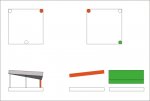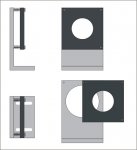HIMNL9
0
- Joined
- May 26, 2009
- Messages
- 5,318
- Points
- 0
I mean this, like in the draw ..... with the screws as you have drawed it, first example, if you move the one in the middle, the plate bend in one direction only, so the beam displace only in one axis, but if you move any of the other 2, as in the example the red one, the plate "rotate" proportionally in 2 different axis at the same time, and also in the height, and the beam do the same thing ..... with the screws in the corners, instead, if you rotate the red one, it roll only in one axis, same for the green one, and only moving the white one it tilt in both axis (and usually you need to move this one for the height only, except some rare cases) ..... in this way, is more easy the fine alignment at the end, when you maybe just need to realign one axis.

Spherical supports with two axis and the highness separate, with a geometrical center, are also better, but requires so much work that are out from the possibility of any hobbysts (and also too much complex, for justify them in an hobbystic mount ..... also professionals use them only in research labs )
)
Spherical supports with two axis and the highness separate, with a geometrical center, are also better, but requires so much work that are out from the possibility of any hobbysts (and also too much complex, for justify them in an hobbystic mount ..... also professionals use them only in research labs










